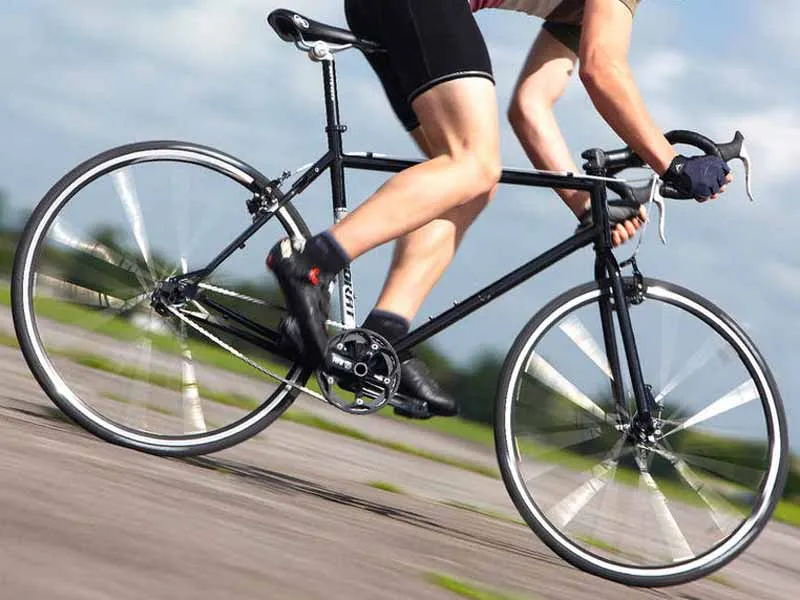Cy Turner’s background is in rail vehicle engineering, where he spent almost 10 years in fields as varied as ride optimisation, structural analysis and project management. Fancying a change of track, he started Cotic, an internet-based bicycle company, in early 2003 as a part-time hobby, which had snow-balled in 2006 to become a full time job.
Cy’s business philosophy is simple: “I try to make the best products I can and let people know I’m pleased they’ve chosen my products.”
Choose your weapon
Cy’s very much of the old school. His personal bikes, and those he encourages his customers to buy, are “steel or titanium for a hardtail, aluminium for full-suspension.”
After a recent move to live and work in the Peak District, he has his Cotic Soul set up with big tyres, big bars and fairly big forks (710mm Bontrager King Earl bars, 2.4in tyres, 130mm forks) and a Hemlock with varying states of development parts, but usually short travel rear, with 160mm forks up front out of preference.
Both, he says, have Hope, Magura, Bontrager and Shimano XT kit as he tends to use the kit he sells, “which,” he says, “comes back to the ‘believing in what you're selling’ thing, with a special nod to Bontrager who sponsor Kate Potter, the Cotic XC team rider.”
For a small company, Cy has managed to get a top-notch racer in the aforementioned Kate Potter, with backing from Keith Bontrager. But, I wondered, what’s more important to him, podiums or customer feedback?
It’s a bit of both, as he explains: “Seeing and hearing about people enjoying my bikes is the biggest kick, the reason to get out of bed in the morning. Racing is cool, but for me, with the Cotic Bontrager Team it’s more about supporting a great aspiring athlete like Kate Potter and giving back something to the sport.
“I also like the fact that it can so quickly change the perceptions of a bike, because Kate rides a titanium Soda, which people all thought was ‘just’ a trail bike until Kate started racing it.”
Carbon shelf life
Cy acknowledges that Carbon, “when done properly with the correct amount of research, can result in some astonishingly light frames, even with the cheaper weaves.” In fact, he’s “frankly amazed that there has been so little quality related failures of the cheaper components available, and that’s a credit to the industry.”
However, he’s staying well clear himself for environmental reasons. “I mean, I know smelting titanium isn’t exactly a low energy exercise, but carbon fibre composites are made entirely of crude oil, are largely un-recyclable, and tend to be made into components with limited lifespans.
“I haven’t fully understood the issue myself, but I think in the frenzy to get carbon parts to market, this is being missed. For my own designs, I prefer trying to do clever things with metal.”
Road bikes with a twist
Cy has also used his mountain bike design brain to create fast handling road bikes with a twist. The flat bar Roadrat has become a commuter classic. “I tell people it’s a road bike for people who don’t like road bikes, and I’m only half joking. I’ve just never got on with drop bar bike handling, as I never grew up with it, coming through BMX then mountain bikes.”
It was developed after Cy spent time suffering on a ‘proper’ drop bar road bike for commuter duties in the Derbyshire countryside. So he adapted his Soul with Mavic Speedcity wheels and an old school XC long stem and flat bars. He also found that disc brakes made perfect sense for commuting, too.
The next step stemmed from the realisation that no one else made a properly committed flat bar road bike. “Hybrids are upright, half-arsed things companies make lazily by slapping flat bars on short road frames. I wanted a proper long speed position and quick intuitive ‘from the wrist’ type handling with flat bars that handled like a mountain bike but had no sacrifice in terms of speed.”
The resulting frame is the Cotic mountain bike shape, with optimised handling for 130mm stems and flat bars, and other parts of the frame redesigned to use proper 700c wheels.
“Because I’m not from a road bike background, I don’t have any hang ups and what you can and can’t put on the frame, so I put everything on it.” Cy says that this versatility is proving popular with his customers, “who can set it up as they please, running it with disc or rim brakes, racks and guards, gears or not; and big tyres or skinny. It’s steel because that’s what I like, too.”
In fact, the conventional drop bar version, with shorter top tubes for a more conventional road bike fit, came out of the fact that one of the major selling points for people was the versatility. “I thought the flat bar geometry was the key thing, but people who like ‘proper’ road bikes also wanted the adaptability, so along came the drop bar one.”
The effect of rising material costs on Cotic and its customers
All Cotic frames are built in Taiwan, as Cy could find no interest in the UK when he started out. As he explains: “In Taiwan, bikes is what they do. It’s the best place in the world to have things built if you can’t build them yourself, and I’m a designer, not a metal worker.
“My first batch of frames were agented by a friend of mine in the industry, but everything now is done directly with one of the largest tubing manufacturers, who organise the build for me. I went to them for the second batch of Souls, and they do all my building now and have been generally brilliant.”
“It’s better to keep building this relationship than chasing the bottom dollar.”
Cy feels that the current rising costs of materials may actually work in his favour: “I guess a company like Cotic is probably in a better position to absorb the odd percent change in commodity price here and there because, with our volumes, we’ll have been paying some of the highest prices for materials, so those prices don’t change so much.”
Whereas, he says, “the larger companies are used to getting the best bulk prices and operating on much larger turnover on a much smaller profit margin, so they will have to alter prices more carefully to stay in profit, hence all the price rises this year from the mainstream players.”
In customer terms, although Cotic has seen a little variance (which Cy believes has largely been negated by exchange rates), their prices remain unchanged for the fourth year in succession.
Moving into mountain bike full suspension territory
Although various other competitors have stayed clear of attempting a full suspension frame so far, Cy was willing to give it a go, believing that he had something to offer. “From an engineering viewpoint it’s a very interesting and fairly complex thing to get your head around. A good challenge, if you like.”
The resulting Hemlock full suspension frame had some neat touches for those looking for a do-it-all bike, especially the ability to interchange between 105mm and 150mm rear travel, and 130-160mm fork lengths without upsetting the geometry for either option.
As Cy explains, “the two travel options are designed to reach the same point with the rider on board, so at ride height the bike is the same between the two. The front end is designed around quick 130mm fork handling, with the strength for 160mm if people want something slack and stable.
“You have about a 30-40mm window of operation on the front end in terms of fork travel before things get odd at one extreme or the other.”
Cy’s set up of choice on his personal Hemlock is to run 140-160mm up front and 105mm out back. To the uninitiated it may seem a strange set-up, but Cy feels that it stems from his background designing and riding long travel hardtails.
It’s a natural progression for him, that he feels hasn’t been catered for anywhere else in the industry. The end result is a full suspension bike that has the option to handle with similar handling balance, yet greater capability, than his hardtails.
He wanted it to be a rider’s bike, not a bike that covers up your mistakes. Cy believes that this “helps on his favourite techy and trialsy terrain, as it’s less wallowy, is greater in grip and precision, while also allowing for a greater margin of error so I feel more satisfied when I clear that difficult section of trail.”
Listen to the feedback
For small companies like Cotic, the past and the future need to be inextricably linked in order to guarantee survival. The Hemlock, for example, has been well received by the bike press, but the reviews and customer feedback have also questioned the bike’s rear flex.
These criticisms were something that Cy readily took on board. “As a designer and bike company owner, you have to take feedback like that seriously, because journalists have a very large pool of experience of other bikes, and your customers’ opinions can be just as valid as your test riders.”
He feels that “the first Hemlock was the best thing we could make at the time, otherwise I wouldn't have released it, but obviously things move on.”
He states that the forthcoming 2009 version will have identical handling and suspension geometry, believing that “these aspects of the original were already easily as good as or better than anything else out there. But, they’ll have improved shocks, with the Fox RP23 fitted as standard, and a much stiffer back end due to larger, stiffer chainstays, a larger swingarm brace and stiffer rocker links.”
The improved stiffer back ends will also be available to existing Hemlock owners should they wish to upgrade. This is a reward, if you like, for the Cotic faithful, something also practised by Turner bikes and Yeti over the years. As Cy explains, “It’s important to me that those early adopters don't get left behind, because they showed a lot of faith in the company.”


